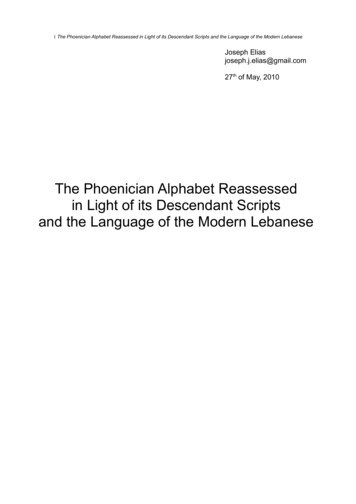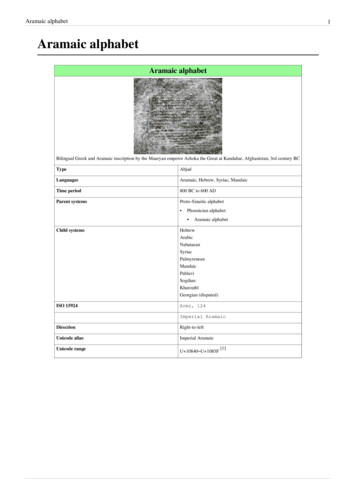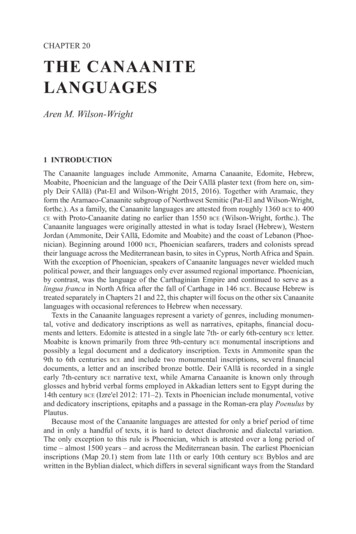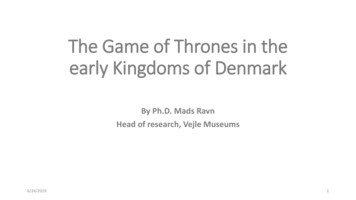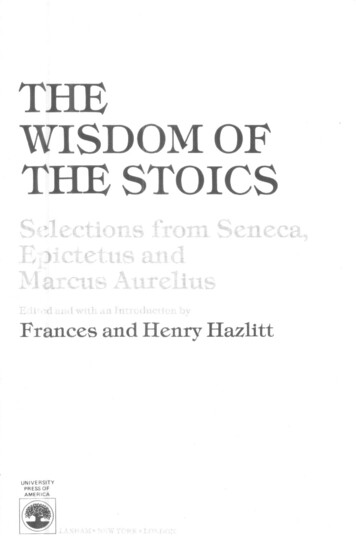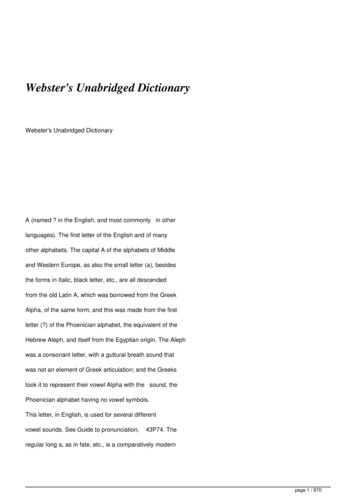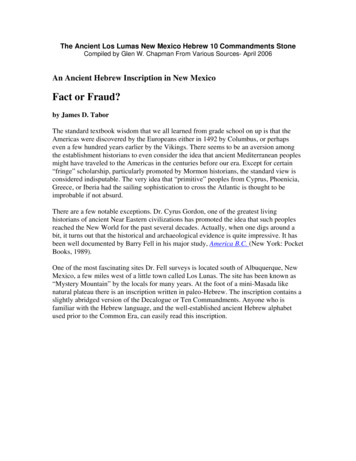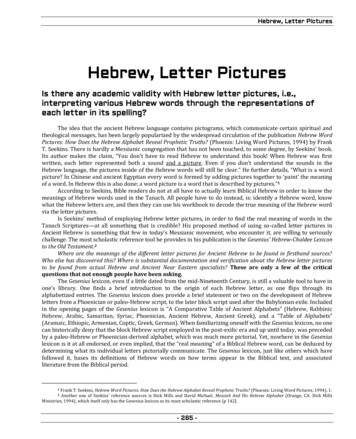
Transcription
Maritime Archaeology Graduate Symposium 201929th – 31st March 2019 Short Report Series.doi: https://doi.org/10.33583/mags2019.03 2020 The AuthorPhoenician amphorae in Cypriot Kingdoms during the Cypro-Archaicand Cypro-Classical Periods: Signs, terms, trade, and questionsChristiana ChristodoulouMA student, University of CyprusAbstractThis paper forms a part of my ongoing MA thesis, which focuses on the Phoenician amphorae recovered onCyprus from the Cypro-Archaic and Cypro-Classical periods. The primary objective of this thesis is thequantitative and qualitative analysis of the published material of the Phoenician amphorae, but it also aims tocontribute to the study of trade relations between Cyprus and the Levant during the Archaic and Classicalperiods. The continuous trade connections between these two areas dates to the second millennium BC and canbe documented by the pottery imports and exports, and epigraphic evidence (Bikai, 1983; Sznycer, 1984; Bikai,1987a). These pieces of evidence are discussed in this paper.Key wordsConnectivity, Cypro-Archaic, Cypro-Classical, Cyprus, Levantine coast, Phoenician Amphorae.IntroductionThis MA thesis aims to study the Phoenician amphorae which were recovered in various archaeological sites inCyprus, from the period of City-Kingdoms (750-310 BC) (Satraki, 2012: 29-30). Consequently, this researchattempts to create a corpus of all the published evidence of Phoenician amphorae from Cypriot archaeologicalsites, to shed more light on different aspects of seaborne trade in the eastern Mediterranean. Through atypological, quantitative and spatial analysis, I hope to understand the exchange patterns between Cyprus and1Honor Frost Foundationhonorfrostfoundation.org
Phoenicia during the Cypro-Archaic and Cypro-Classical periods. Moreover, I will clasify the specific types ofPhoenician amphorae that were exported to Cyprus, and I will try to refine their typology and chronology, inorder to contribute to the study of Phoenician amphorae in Cyprus and the eastern Mediterranean generally.Interconnections between Cyprus and Phoenicia in the second and first millennia BCPhoenicians first began venturing on the Mediterranean Sea during the second millennium BC (Ιοannou, 2015:3). Archaeological remains of Phoenician activity on Cyprus dated from the 12 th-11th centuries BC show thepresence of strong Phoenician elements in Cypriote art and culture and prove the interconnections betweenCyprus and Phoenicia (Karageorghis, 2005: 31). The first evidence of Phoenician presence was found atPalaepaphos in the western part of Cyprus. This Phoenician evidence appeared in Palaepaphos-Skales from thebeginning of the Iron Age (11th century BC) (Bikai, 1987b).Furthermore, it is widely believed that Phoenicians had settled on the island, specifically at Kition, by the midninth century BC (Gjerstad, 1979: 232-233; Knapp, 2008: 368). The proximity of Cyprus to the Levant ensuredtrade and contact between the two areas from an early time, as the contacts were usual with other neighboringgroups, such as Greeks, Egyptians, Anatolians, etc. in the eastern Mediterranean (Reyes 1994: 21). Cypriots andPhoenicians would also have met elsewhere in the Levant and Egypt (Reyes, 1994: 18). At the beginning of theCypro-Archaic period, Cypriots and Phoenicians stayed side by side on the island.Phoenician Amphorae: Typological, Morphological and Chronological aspectsAmong the earliest evidence of the long-distance mercantile exchange of raw materials and luxury commoditiesin the ‘Canaan land’ are Canaanite jars from the Late Bronze Age. Canaanite jars were the ancestral type of thePhoenician amphorae and appeared from the second millennium BC (Middle Bronze Age II/Late Bronze Age)(Fig. 1) in the Levant to Punic times in the western Mediterranean (Sagona, 1982: 73; Regev, 2004: 337).During the Iron Age in the Mediterranean, two main types of amphora shapes were distributed: (1) the Greekstyle, and (2) the Levantine style. Phoenician amphorae have distinctive morphological differences from theGreek ones, which are: (1) the low or non-existent neck, and (2) the vertical loop handles. Some of them haveone or no handles on the shoulder (Sagona, 1982: 86; Beetle, 2003: 21) (Fig. 2). Large quantities of Iron AgePhoenician amphorae have been recovered at various sites on Cyprus. The majority of these sites are thenecropoleis of each city-kingdom, such as Kition-Bamboula (Hadjisavvas 2012). Consequently, I assume thattrade activity between Cyprus and Phoenicia was at its zenith during this period.Before discussing the different types of Phoenician amphorae, it is good to define what ‘amphora’ means. Likeall ceramic vessels, amphorae are made of clay, an easily accessible and low-cost material throughout the ancientworld (Rice, 1987: 207; Demesticha and Knapp, 2016). Amphora, as Whitbread (1995: 31) explains, ‘has a verydistinguished shape that allowed to us to recognize them from other ceramic vessels’. Moreover, the mostcommon use of this vessel was as a maritime transport container; as a result, their shape was most functionalfor stowage in ships (Demesticha and Knapp, 2016: 5-6). On land, the distribution of amphorae was moredifficult and time-consuming.2Honor Frost Foundationhonorfrostfoundation.org
Furthermore, amphorae represent important aspects of the economic history of the Mediterranean, because theywere the most common transport and storage containers designed to transfer liquid and solid products in bulk,over long distances in the sea (Hein et al., 2008: 1049). Amphorae were used for packaging agricultural productssuch as wine, olive oil, etc. According to Virginia Grace (1979: 1), a pioneer in amphora studies, ‘Amphoraehave three main characteristics in common: a neck or mouth narrow enough to be corked, two opposite verticalhandles and a tip or knob base, that functioned as a third handle for their transport’. Virginia Grace did notinclude vessels with a flat base in this definition. Later, Peacock and Williams (1986: 5) modified her definitionand considered flat-based vessels as transport amphorae as well. Many more definitions have been publishedsince then (Demesticha, 2001: 2; Demesticha and Knapp, 2017: 36-43).Moving to the case study of Phoenician amphorae, the term 'Phoenician amphora' defines the regionalproduction and origin of the type of vessel from Phoenicia, which is the region on the Levantine coast, betweenthe mountains of Lebanon and the Mediterranean Sea. Its north and south boundaries are more or less from TellSuqas (Shukshu) or Arvad (Ancient Aradus) to Akko (Aubet, 1993: 12-13; Moscati, 1999: 5) (Fig. 3). ThePhoenician mainland stretches for 200 kilometers from north to south, and is crossed by numerous small rivers.The highest peak of the Mount Lebanon range is more than 3000 metres above sea level and provides timberused for shipbuilding (Ioannou, 2015: 3).The first evidence of Phoenician amphorae, dated to the Levantine Iron Age I period (c.1200-900 BC), wererecovered on the Levantine coast, Cyprus, and Crete. In the Levantine Iron Age II period (c. 900-700 BC),distribution was wider than during the Iron Age I period. However, evidence was not recovered in mainlandGreece until recently (Martin, 2017: 102). Moreover, two main types of amphorae existed in the Iron Age: (1)the rounded, and (2) the elongated versions (Regev, 2004: 340; Martin, 2017: 102) (Fig. 2).Scholars who examined the Levantine-styled amphorae mentioned them with various ‘names’, such as jars,amphora, storage jars, transport amphorae, crisp ware, or wasp-like (Sagona, 1982). For instance, the SwedishCyprus Expedition that conducted extensive excavations on the island did a typological analysis of the mainpottery recovered in Cypriot archaeological sites (Winbladh, 2003:13) (Fig. 4). However, somemisinterpretations can be distinguished, as transport amphorae, for example, are listed as pithoi. Consequently,one of my thesis objectives is to re-examine the terminology and the descriptions of Phoenician transportamphorae from numerous publications that have used the Swedish Cyprus Expedition's typology extensively.Thus far, more than 250 Phoenician amphorae dated to Cypro-Archaic and Cypro-Classical periods have beenfound in various sites in Cyprus, including the settlements of Kition and Idalion (Karageorghis, 1985;Hadjicosti, 2016), the necropolis at Kition (Hadjisavvas, 2012), the anchorage at Kioni (Leonard, 1995: 155156), and rural sites such as Panayia Ematousa (Jacobsen, 2006: 311) (Fig. 5).On some amphorae, Phoenician inscriptions in ink have been found. The majority of them were found betweenthe handles or on the shoulders. These inscriptions mainly referred to the god Baal. Some of these inscriptionsreferred to the owner of the amphora, and those amphorae might have beenused as votive offerings withinchamber tombs (Allan, 2004: 241).3Honor Frost Foundationhonorfrostfoundation.org
Moreover, some of the scholars who examined the Phoenician amphorae on the island have argued that Cypriotimitations of Phoenician amphorae existed, but none of these scholars performed fabric analysis on theamphorae, and without this analysis, it is not easy to distinguish the origin of these amphorae (Amiran, 1969;Sagona, 1982; Bikai, 1983: 25; Jacobsen, 2006: 311). In my thesis, I will not include any such analysis, but inthe future, it will be necessary, especially for some Phoenician amphorae which have different typologicalfeatures.ConclusionsTo conclude, Cyprus was one of the critical geographic areas in the eastern Mediterranean basin as the nearestisland to the Levantine coast. The contacts between of these two areas (Cyprus and Phoenicia) areincontrovertible, evidenced not only by the epigraphic materials (Sznycer, 1984: 117 – 121) found at Kition,but also from the archaeological material, including pottery.Over 250 different types of Phoenician amphorae will be included in this Masters thesis from variousarchaeological sites in Cyprus. Up to 20 sites will be mentioned (necropoleis, settlements, and anchorages), andmost of them are included in the power of each city kingdom’s periphery. Large quantities of Phoenicianamphorae have been found near coastal city-kingdoms, including Kition, Salamis, and Marion. FewerPhoenician amphorae have been recovered from inland parts of Cyprus (Tamassos and Ledra).Finally, Lapethos and Soloi, located at the northern part of Cyprus are not mentioned in this thesis, because theonly evidence recovered in these sites date from the Cypro-Geometric and Byzantine periods respectively. Themain reason that archaeological evidence from the Cypro-Archaic and Cypro-Classical periods has not beenrecovered in the northern part of Cyprus is that the archaeological sites dated from these periods have not beenaccessible since the Turkish invasion in 1974 (Gagniers 1985; Diakou 2019). This is one of the limitations ofmy master thesis, which might be overcome in the future.AcknowledgementsFor my first paper publication, I would like to thank the MAGS 2019 committee. I am also grateful to the HonorFrost Foundation for awarding me by the bursary and also for the opportunity to present at the MAGS 2019 andpublish my work. Finally, I would like to sincerely thank my MA supervisor, Dr. Stella Demesticha, who isalways next to me in this path of Maritime Archaeology.Reference ListAllan, R., 2004, An inscribed amphora from Deneia. Report of the Department of Antiquities, Cyprus, 241-243.Amiran, R., 1969, Ancient pottery of the Holy Land: from its beginnings in the Neolithic period to the end ofthe Iron Age. Massada: Massada Press.Aubet, E., 1993, The Phoenicians and the West: politics, colonies and trade. New York: Cambridge UniversityPress.Beetle, E., 2003, Phoenician Amphorae of the Persian Period (539-332 BC). Oxford: Archaeopress.4Honor Frost Foundationhonorfrostfoundation.org
Bikai, P., 1983, The Imports from the East, in V. Karageorghis (ed.), Palaepaphos-Skales. An Iron AgeCemetery in Cyprus, 396-405.Bikai, P., 1987a, The Phoenician pottery of Cyprus. Larnaca: A.G. Leventis Foundation.Bikai, P., 1987b, Trade networks in the early iron age, in D. Rupp (ed.), Western Cyprus: connections: anarchaeological symposium held at Brock University, St. Catharines, Ontario, Canada, March 21-22, 1986, 125128. Goteborg: Astroms.Bikai, P., 1992, Cyprus and Phoenicia: Literary Evidence for the Early Iron Age, in G. Ioannides (ed), Studiesin honour of Vassos Karageorghis, 241-248. Nicosia: Society of Cypriot Studies.Calvet, Y., 1980, Sur certains rites funeraires a Salamine de Chypre, in M. Yon (ed.), Salamine de Chypre,histoire et archeologie: etat des recherches, 115-121. Paris: Εditions du Centre national de la Recherchescientifique.Demesticha, S., 2001, Οι Κυπριακοί αμφορείς της Ύστερης Ρωμαϊκής περιόδου. Λευκωσία: ΠανεπιστήμιοΚύπρου.Demesticha, S. and Knapp, B., 2016, Introduction, in S. Demesticha and B. Knapp (ed.), Maritime transportcontainers in the Bronze-Iron Age Aegean and Eastern Mediterranean, 2-6. Uppsala: Astroms forlag.Diakou, S., 2019, The upper Geometric cemetery at Lapithos: University of Pennsylvania Museum Excavations,1931-1932. Uppsala: Astrom Editions.Gagniers, J., 1985, Soloi: dix campagnes de fouilles, 1964-1974. Sainte-Foy: Presses de l'Universite Laval.Gjerstad, E., 1960, Pottery Types: Cypro-Geometric to Cypro-Classical. Opuscula Athiensia VII, 105-116.Gjerstad, E., 1979, The Phoenician colonization and expansion in Cyprus: the pre-Phoenician Kition. Nicosia:Department of Antiquities Cyprus.Grace, V., 1979, Amphoras and the ancient wine trade. Princeton: American School of Classical Studies atAthens.Hadjicosti, M., 2016, The Kingdom of Idalion in the Light of New Evidence. Bulletin of the American Schoolsof Oriental Research 308, 49-63.Hadjisavvas, S., 2012, The Phoenician period necropolis of Kition. Nicosia: Department of Antiquities Cyprus.Hein, A., Georgopoulou, V., Nodarou, E. and Kilikoglou, V., 2008, Koan amphorae from Halasarna einvestigations in a Hellenistic amphora production centre. Journal of Archaeological Science 35, 1049-1061.Ioannou, C., 2015, Cypriotes and Phoenicians. [Online] Avalable: kyprioscharacter.eie.gr/en/t/Ac. Lastaccessed 09/05/2019.Jacobsen, K., 2006, Transport amphorae, in L. Sorensen and K. Jacobsen (eds.), Panayia Ematousa I, 303-336.Aarhus: Aarchus University Press.Karageorghis, V., 1985, Excavations at Kition. Nicosia: Published for the Republic of Cyprus by the Departmentof Antiquities.Karageorghis, V., 2003, The Cyprus collections in the Medelhavsmuseet. Nicosia: The A. G LeventisFoundation.5Honor Frost Foundationhonorfrostfoundation.org
Karageorghis, V., 2005, Some aspects of everyday life in Archaic Cyprus, in H. Matthäus and S. Rogge (eds),Cyprus: Religion and Society from the Late Bronze Age to the End of the Archaic Period, 111-125. Shulpat.Knapp, B., 2008, Prehistoric and protohistoric Cyprus: identity, insularity, and connectivity. Oxford: OxfordUniversity Press.Leonard, R. J., 1995, The anchorage at Kioni, in J. Fefjer (ed.), Ancient Akamas I. Settlement and environment,133-156. Aarchus Oakville: Aarhus University Press.Martin, R., 2017, Iron Age Levant: Background and History of Research, in B. Knapp and S. Demesticha (eds.),Mediterranean Connections: Maritime transport containers and seaborne trade in the Bronze and Iron ages,102-129. New York: Routledge.Moscati, S., 1999, The world of the Phoenicians. London: Phoenix Giant.Peacock, D., and Williams, D., 1986, Amphorae and the Roman economy: an introductory guide. London:Longman.Regev, D., 2004, The Phoenician Transport Amphora, in J. Eiring and J. Lund (eds.), Transport amphorae andtrade in the Eastern Mediterranean: acts of the international colloquium at the Danish Institute at Athens,September 26-29, 2002, 337-352. Aarhus: Aarhus University Press.Reyes, A., 1994, Archaic Cyprus: a study of the textual and archaeological evidence. Oxford: Clarendon Press.Rice, P., 1987, Pottery Analysis: A sourcebook. Chicago: The University of Chicago Press.Sagona, A., 1982, Levantine Storage Jars of the 13th to 4th century B.C. Opuscula Athiensia XIV, 73-108.Sznycer, M., 1984, Inscriptions Pheniciennes sur jarres de la necropole D' Ayios Georghios. Report of theDepartment of Antiquities, Cyprus, 117-121.Satraki, Α., 2012, Κύπριοι βασιλείς από τον Κόσμασο μέχρι το Νικοκρέοντα: η πολιτειακή οργάνωση της αρχαίαςΚύπρου από την 'Υστερη Εποχή του Χαλκού μέχρι το τέλος της Κυπροκλασικής περιόδου με βάση τα αρχαιολογικάδεδομένα. Αθήνα: Πανεπιστήμιο Αθηνών.Whitbread, I., 1995, Greek transport amphorae: a petrological and archaeological study. Athens: BritishSchool at Athens.Winbladh, M., 2003, The Cyprus Collections in the Medelhavsmuseet, in V. Karageorghis (ed.), The CyprusCollections in the Medelhavsmuseet, 13-30. Nicosia: The A. G. Leventis Foundation.6Honor Frost Foundationhonorfrostfoundation.org
FiguresFig. 1: Chronological Table (Karageorghis, 2003: xiii).7Honor Frost Foundationhonorfrostfoundation.org
Fig. 2: Various Phoenician types found in Cypriot archaeological sites (Gjerstad, 1960: 112).8Honor Frost Foundationhonorfrostfoundation.org
Fig. 3: Phoenicia as S. Moscati and E. Aubet defined its boundaries, according to the archaeological remains(Moscati, 1999: 5).9Honor Frost Foundationhonorfrostfoundation.org
Fig. 4: The four members of the Swedish Cyprus Expedition (Winbladh, 2003: 14).Fig. 5: Cypriot archaeological sites, where Phoenician amphorae were recovered ( Ch. Christodoulou;Google Earth).10Honor Frost Foundationhonorfrostfoundation.org
Before discussing the different types of Phoenician amphorae, it is good to define what 'amphora' means. Like all ceramic vessels, amphorae are made of clay, an easily accessible and low-cost material throughout the ancient world (Rice, 1987: 207; Demesticha and Knapp, 2016). Amphora, as Whitbread (1995: 31) explains, 'has a very
